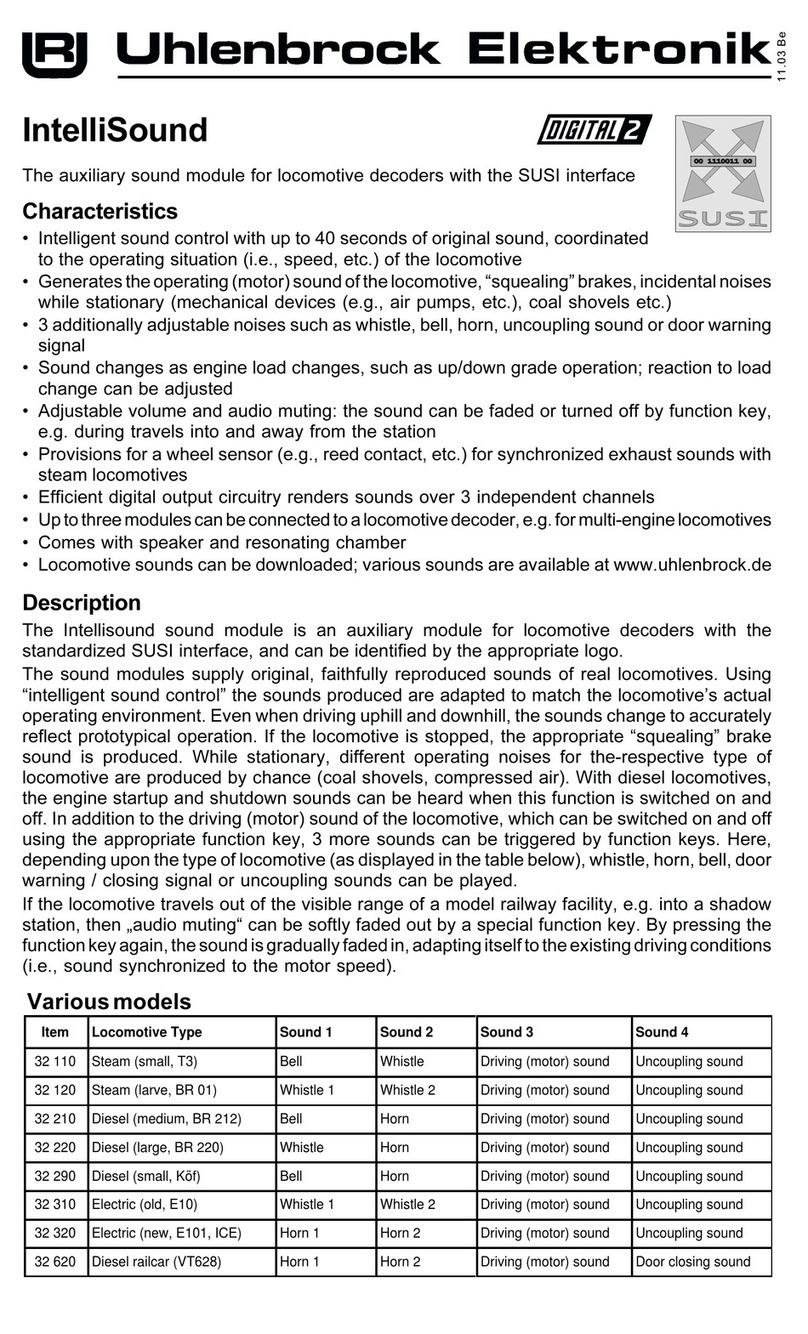Track Circuit selection
Track circuit selection varies according to the
control device being used. In the following
section each device is briefly described. For
more detailed description refer to the manual for
that device.
Track Circuit selection with DAISY
A DAISY handcontroller connected to the
LocoNet socket of a Power 2 automatically
recognises analogue operation and displays the
letter “A” as the data format. With factory setting
it will control track circuit 1. The [lok] key can be
used to select another track circuit.
Track Circuit selection with FRED
Firstly FRED must be configured as for operating
with a TwinCenter. Using the function keys you
can change FRED’s LocoNet ID. The meaning of
the ID selection is:
ID 1 – track circuits 1 to 4 (factory setting) etc. to
ID 16 – track circuits 61 to 64
After this is set up one of the 4 track circuits can
be selected by pressing the [lok] key followed by
one of the function keys [f1] to [f4].
Track Circuit selection with IB-Control
No setting up is required. The track circuits are
selected as in selecting a locomotive decoder.
•Press [lok]-key
•Enter the address of the track circuit using the
numeric keys
•Press the [ ]-key for it to take effect
Track Circuit selection with Profi-Control
8 track circuits can be controlled with each Profi-
Control. Which 8 is determined by the LocoNet
ID:
ID 1 – track circuits 1 to 8 (factory setting) etc. to
ID 8 – track circuits 57 to 64
After this is set up one of the 8 track circuits can
be selected by pressing the [stop] key followed by
one of the function keys [f1] to [f8].
Coupling two track circuits
With a DAISY system it is possible to momentarily
couple the track circuit where the locomotive is
with the next track circuit. All the locomotive’s
parameters, such as speed, direction and state of
the special functions can then be transferred
between the sections. As soon as the locomotive
has left the old circuit, the coupling is released.
Method:
•Press [function] or [Light] key on the controller
or control panel. The control LED flashes.
•Select the new track circuit on the controller and
switch the light function on. Both track circuits
are now controlled with the settings of the first
track circuit.
Important: The DAISY system can only process
one coupling operation. That is, you must
complete one coupling operation before you can
start the next.
•As soon as the locomotive has reached the new
section (circuit) the coupling in which the light
was switched off will be released.
Handling a short circuit
If a short circuit occurs on the layout only the
Power 2 connected to that circuit will shutdown.
The shut down Power 2 can be turned back on, if:
•a DAISY handcontroller has the [stop] key is
pressed
•a FRED for the selected track circuit has the
[stop] key is pressed
•an IB-Control has the [go] key is pressed
•a Profi-Control for the selected track circuit has
the travel direction lever is set to 0 and then to
the desired speed.
Operation of a reversing loop on an
analogue layout
Power 2 is compatible with reversing loop
trimmings that are provided by the track
manufacturers.
The reversing loop automation cannot be used as
most switch the polarity of the outer part of the
track via a reversing switch. In a DAISY system
the system earth must always be on the same
side of the track to prevent short circuits when the
locomotive crosses to another track circuit.
Wiring
In order to automate or partially
automate a reversing loop in a
layout Power 2 uses one input to
switch the present direction over for
the controller. To reverse the
direction Pin 1 and Pin 2 of the
booster input must be connected. Adapter plug
61 050 can be used for this connection.
Important: The last Power 2 in the chain of
analogue boosters - to whose LocoNet socket the
controllers are connected – must not be fitted with
this polarity control.
Special functions in analogue systems
Via the special function of each of the connected
controllers you can achieve things in an analogue
system that are normally only possible in digital
systems.
Note: The function only operates in the track
circuit connected to the Power 2 for which the
function has been activated.

























